Exploring the French Backcountry Along the Route of ‘Tour de France’ in Ten Stages. The ‘Tricolore’ in Red, White and Rosé. (10-Bottle Pack $291, Tax Included)
Exploring the French Backcountry Along the Route of ‘Tour de France’ in Ten Stages. The ‘Tricolore’ in Red, White and Rosé.
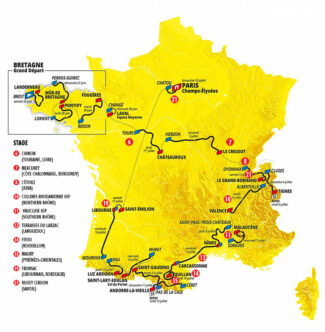 The terrain is rough but the terroir is sweet! The Tour de France was founded in 1903—which, for the record, was not a bad vintage for French wine either—and aligning the Tour de France with a ‘Pour’ de France is not difficult; the annual, multi-stage bicycle race traces a serpentine route through some of the best and unexplored wine country in France. We take up the course in Stage 6 (Tours to Châteauroux), when, this year, 177 riders arrived in the ‘the Garden of France’—the heart of the Loire—then followed a circuitous course that will finish with a sparkling celebration of victory in the Parisian bosom, Champs-Élysées. The wines in this package showcase the variety of styles and substances that spring from the soils beneath the rubber tires of world’s most heralded bicycle racers.
The terrain is rough but the terroir is sweet! The Tour de France was founded in 1903—which, for the record, was not a bad vintage for French wine either—and aligning the Tour de France with a ‘Pour’ de France is not difficult; the annual, multi-stage bicycle race traces a serpentine route through some of the best and unexplored wine country in France. We take up the course in Stage 6 (Tours to Châteauroux), when, this year, 177 riders arrived in the ‘the Garden of France’—the heart of the Loire—then followed a circuitous course that will finish with a sparkling celebration of victory in the Parisian bosom, Champs-Élysées. The wines in this package showcase the variety of styles and substances that spring from the soils beneath the rubber tires of world’s most heralded bicycle racers.
Official Website of Tour de France 2021.
We are pleased to offer one bottle of each of the following ten wines for a price of $291, tax included.
STAGE 6 – Touraine, Loire – Rosé
Chinon: Chinon perches above the River Vienne in Indre-et-Loire on soils composed almost entirely of erosional scree, gravel and hard Turonian limestone. This is ideal for the production of mineral-driven reds made from Cabernet Franc, and also lends itself a small quantity of spicy rosé.
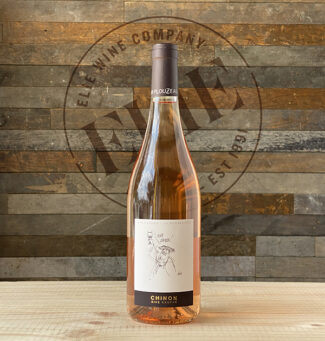 Château de la Bonnelière ‘M Plouzeau – Rive Gauche’ 2020 ($17): Rive Gauche’ translates literally as ‘Left Bank’, and refers to the Vienne, where Château de la Bonnelière has been in the Plouzeau family since 1846. Marc Plouzeau took over in 1988 with a game plan that included lowering yields and hand-harvesting at ideal physiological ripeness. His 2020 Rosé is a crunchy delight with watermelon and strawberry notes and great overall depth that brings out elements of cantaloupe, ripe red pepper and a beguiling black cherry undercurrent adding weight and complexity.
Château de la Bonnelière ‘M Plouzeau – Rive Gauche’ 2020 ($17): Rive Gauche’ translates literally as ‘Left Bank’, and refers to the Vienne, where Château de la Bonnelière has been in the Plouzeau family since 1846. Marc Plouzeau took over in 1988 with a game plan that included lowering yields and hand-harvesting at ideal physiological ripeness. His 2020 Rosé is a crunchy delight with watermelon and strawberry notes and great overall depth that brings out elements of cantaloupe, ripe red pepper and a beguiling black cherry undercurrent adding weight and complexity.
STAGE 7 – Côte Chalonnaise, Burgundy – White
Mercurey: In Burgundy’s sub-region of Côte Chalonnaise, Mercurey is rolling patchwork of vineyards covering around 1600 acres of limestone-rich soil. Named for the Roman God Mercury, it is fitting that the AOP is known predominantly for red wines made. Yet the whites—though making up less than 10% of Mercurey’s output—are beautifully nuanced Chardonnay-based gems.
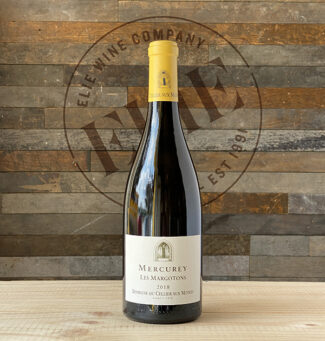 Domaine du Cellier aux Moines ‘Les Margotons’ 2018 ($31): Situated in one of Givry’s historic Premier Crus, the Cellier aux Moines was magnificently restored by Catherine and Philippe Pascal, who also expanded their offerings by purchasing several small plots of Chardonnay vines in Mercurey, including ‘Les Margotons’. The vines are grown in limestone marl and the wine has a sensuous, tropical nose replete with pineapple and papaya; it is round and rich on the palate with citrus notes and soft hazelnut on the finish.
Domaine du Cellier aux Moines ‘Les Margotons’ 2018 ($31): Situated in one of Givry’s historic Premier Crus, the Cellier aux Moines was magnificently restored by Catherine and Philippe Pascal, who also expanded their offerings by purchasing several small plots of Chardonnay vines in Mercurey, including ‘Les Margotons’. The vines are grown in limestone marl and the wine has a sensuous, tropical nose replete with pineapple and papaya; it is round and rich on the palate with citrus notes and soft hazelnut on the finish.
STAGE 8 – Jura – White
L’Étoile: A tiny appellation (130 acres) in southwestern Jura—itself a small département between Burgundy and Switzerland—L’Étoile is French for ‘the star’, likely referring to the starfish fossils found in the clay/limestone and grey/blue marne soil. This is ‘vin jaune’ country—an unusual Sherry-style wine made from the local Savagnin grape and developed using a flor-like strain of yeast.
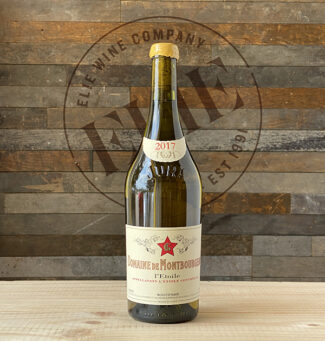 Domaine de Montbourgeau 2017 ($30): Nicole Deriaux’s grandfather planted the first Montbourgeau vines in 1920. As the current vigneron, Deriaux is dedicated to organic agriculture and vinifies according to the traditional methods of the appellation. Although it is made primarily of Chardonnay, the delightfully zesty dry wine carries vin jaune notes reminiscent of Fino: Chamomile, candied lemon peel and yeasty brioche braced by a resonant acidity.
Domaine de Montbourgeau 2017 ($30): Nicole Deriaux’s grandfather planted the first Montbourgeau vines in 1920. As the current vigneron, Deriaux is dedicated to organic agriculture and vinifies according to the traditional methods of the appellation. Although it is made primarily of Chardonnay, the delightfully zesty dry wine carries vin jaune notes reminiscent of Fino: Chamomile, candied lemon peel and yeasty brioche braced by a resonant acidity.
STAGE 10 – Northern Rhône – Red
Collines Rhodaniennes IGP: ‘IGP’ is the Europe-wide equivalent of ‘Vin de Pays’ (Country Wine), a classification that focuses on geographical origin rather than style and tradition, giving winemakers greater stylistic freedom than ‘AOP’. Collines Rhodaniennes is in the northern Rhône Valley, and covers an area from Lyon to Montélimar and includes some of southern France’s most famous AOP appellations, including Côte Rôtie, Condrieu and Hermitage.
 Stéphane Ogier ‘La Rosine – Syrah’ 2016 ($35): Having studied in Beaune, owner and winemaker Stéphane Ogierdraws from 27 acres of his family’s estate in some of the most famous Côte-Rôtie areas, such as Lancement, Côte-Rozier, and La Viallière. He produces several Syrah-based wines, including La Rosine, a full-bodied, richly-textured mouthful with caramel and mocha on the nose and brambleberries on the mid-palate, especially black raspberries and red currants.
Stéphane Ogier ‘La Rosine – Syrah’ 2016 ($35): Having studied in Beaune, owner and winemaker Stéphane Ogierdraws from 27 acres of his family’s estate in some of the most famous Côte-Rôtie areas, such as Lancement, Côte-Rozier, and La Viallière. He produces several Syrah-based wines, including La Rosine, a full-bodied, richly-textured mouthful with caramel and mocha on the nose and brambleberries on the mid-palate, especially black raspberries and red currants.
STAGE 11 – Vaucluse, Southern Rhône – Red
Vaucluse IGP: Situated in the heart of the Southern Rhône Valley, Vaucluse encompasses such fabled winegrowing villages as Châteauneuf-du-Pape, Gigondas and Vacqueyras. The IGP classification allows growers to experiment with grape varieties and winemaking techniques that fall outside of the AOP-level appellation requirements.
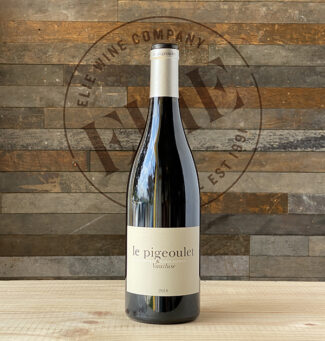 Selon Frédéric & Daniel Brunier ‘Le Pigeoulet’ 2018 ($17): The brothers Frédéric & Daniel represent the fourth generation of Brunier to farm Châteauneuf-du-Pape at Domaine du Vieux Télégraphe; they produce the ‘Le Pigeoulet’ cuvée from the identical Châteauneuf-du-Pape terroir, but this wine is primarily Grenache. It shows luscious blackberries, herbs and licorice contained within a flamboyant Rhône package that balances elegance and muscle.
Selon Frédéric & Daniel Brunier ‘Le Pigeoulet’ 2018 ($17): The brothers Frédéric & Daniel represent the fourth generation of Brunier to farm Châteauneuf-du-Pape at Domaine du Vieux Télégraphe; they produce the ‘Le Pigeoulet’ cuvée from the identical Châteauneuf-du-Pape terroir, but this wine is primarily Grenache. It shows luscious blackberries, herbs and licorice contained within a flamboyant Rhône package that balances elegance and muscle.
STAGE 13 – Hérault, Languedoc – Red
Terrasses du Larzac: Among the independent subdivisions of Languedoc-Roussillon, one rising star is rapidly becoming a supernova. Having been formed in 2005 and not officially recognized until 2014, Terrasses du Larzac contains some of the highest elevations in the Languedoc—vineyard plots snake along the Cévennes range and produce wines that are notably distinct from its nearest neighbors, including those from the oldest appellation in France, Roquefort.
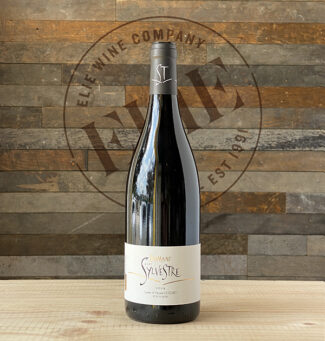 Domaine Saint Sylvestre 2014 ($33): Having launched Domaine Saint Sylvester in 2010 from a trio of lots totaling less than twenty acres, the wines quickly showcased the talent and passion of owners Sophie and Vincent Guizard. Their style of red wine presents jazzy bravura—cherries, raspberries and red currants on the nose, and mid-palate to finish it offers the peculiar herbal-ness that the French call ‘garrigue’.
Domaine Saint Sylvestre 2014 ($33): Having launched Domaine Saint Sylvester in 2010 from a trio of lots totaling less than twenty acres, the wines quickly showcased the talent and passion of owners Sophie and Vincent Guizard. Their style of red wine presents jazzy bravura—cherries, raspberries and red currants on the nose, and mid-palate to finish it offers the peculiar herbal-ness that the French call ‘garrigue’.
STAGE 14 – Aude, Roussillon – Red
Fitou: Situated in the warm core of Roussillon a few miles from the Mediterranean coast, Fitou boasts a proud winemaking tradition. The soils tend to be poor, but free draining, and the yields are small, leading to concentrated red wines built around a primary blend of Carignan and Grenache and often displaying Fitou’s characteristic herbalness and meaty rusticity.
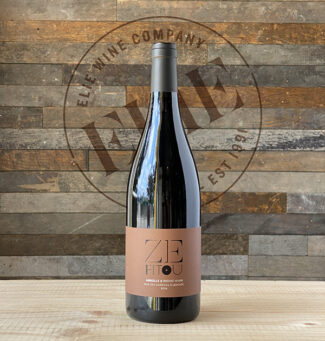 Mas des Caprices ‘Ze Fitou’ 2016 ($24): Mireille and Pierre Mann established Mas de Caprices near the seaside resort of Leucate in the Corbières Maritimes, where, the combined forces of water and wind wreak both havoc and harmony throughout the vineyards. This wine shows a supple nose of macerated fruit and game, with a full-bodied spiciness with licorice and velvety tannins.
Mas des Caprices ‘Ze Fitou’ 2016 ($24): Mireille and Pierre Mann established Mas de Caprices near the seaside resort of Leucate in the Corbières Maritimes, where, the combined forces of water and wind wreak both havoc and harmony throughout the vineyards. This wine shows a supple nose of macerated fruit and game, with a full-bodied spiciness with licorice and velvety tannins.
STAGE 15 – Pyrénées-Orientales, Roussillon – Red
Maury: Maury is an appellation in northern Roussillon best known for sweet ‘vins doux naturels’ made from Grenache. Looking for a broader audience, a separate appellation was created in 2011 to focus on dry red wines made from the same grape, with Mourvèdre, Syrah and Carignan also permitted. Maury’s terrain is dominated by steep limestone cliffs, marking the beginning of the Pyrénées foothills; vines planted at these altitudes produce some of the fullest-bodied wines in France.
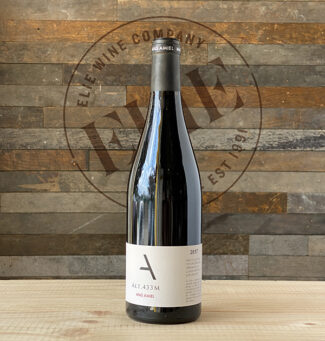 Mas Amiel ‘Alt 433 m’ 2017 ($36): As the name suggests, Mas Amiel’s most elevated vines—including those of the natural Grenache mutation known as Lladoner Pelut—are planted in 1952 on a mountain slopes composed of gneiss and micaschist. Cool nights maintain acidity, giving this sericeous wine a pristine bite and violet aromatics while warm days allow rich red fruit flavors to develop, especially black cherries, jammy strawberry and cassis along with exotic spices.
Mas Amiel ‘Alt 433 m’ 2017 ($36): As the name suggests, Mas Amiel’s most elevated vines—including those of the natural Grenache mutation known as Lladoner Pelut—are planted in 1952 on a mountain slopes composed of gneiss and micaschist. Cool nights maintain acidity, giving this sericeous wine a pristine bite and violet aromatics while warm days allow rich red fruit flavors to develop, especially black cherries, jammy strawberry and cassis along with exotic spices.
STAGE 19 – Libournais, Bordeaux – Red
Fronsac: Often called ‘the Tuscany of the Gironde’ for its spectacular hillside vineyards overlooking the gentle Dordogne and the river Isle, Fronsac lies just to the west of Saint-Émilion and Pomerol. Like its more famous neighbors, this AOP relies chiefly on Merlot, which thrives especially well in Fronsac’s ‘molasse de Fronsadais’—a subsoil composed of clay, sandstone and limestone.
 Château Villars 2015 ($25): 2015 was a fine vintage in Fronsac, with none of the late-season frost that dogged previous harvests. Château Villars’s wine shows sensational balance with a plush core of sweet mulberry, a complex mid-palate with red fruit and flowers and a slight tinge of clove on the finish along with delightfully intertwined tannins.
Château Villars 2015 ($25): 2015 was a fine vintage in Fronsac, with none of the late-season frost that dogged previous harvests. Château Villars’s wine shows sensational balance with a plush core of sweet mulberry, a complex mid-palate with red fruit and flowers and a slight tinge of clove on the finish along with delightfully intertwined tannins.
STAGE 21 – Savoie – Sparkling Rosé (Champs-Élysées – Paris)
After more than three weeks of racing, The Tour de France reaches its grand finale at the finishing line on the Avenue des Champs-Elysées on July 18th., where the coveted yellow jersey is bestowed upon the winner with much fanfare… and champagne.
For our celebration, we prefer a demi-sec sparkling rosé from the mountainous Savoie region of eastern France. Bugey Cerdon: Cerdon—one of three sub-appellations of Bugey—produces a single style of wine, and does it better than anyone else: sparkling rosés made from Gamay and Poulsard (an indigenous, thin-skinned variety). The advantage Cerdon has over much of the region is found in its hillside slopes that face south east, where early morning sunshine and free draining soils prove ideal for a slower, more consistent ripening of grapes.
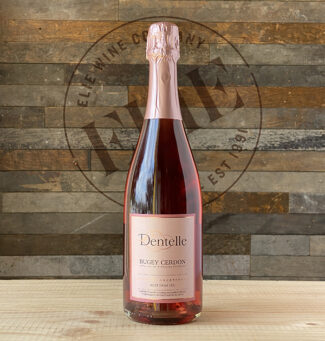 La Dentelle Demi-Sec multi-vintage ($26): There is a remarkable story behind this wine: Marcel Perinet began his career as a waiter, then became a sommelier (best in France in 1978) and rose to serve as director of 3–Michelin-starred Georges Blanc in Vonnas. After 41 years at Blanc, Perinetinherited two and a half acres of land in Cerdon du Bugey and set out to produce one of the best sparkling rosés in Savoie. Made using ‘méthode ancestrale’ (which differs from Champagne’s ‘méthode traditionelle’ in that there is no second application of yeasts or sugars during production), leaving residual sugars and alcohol at 8.5%, Perinet’s off-dry wine is wonderfully effervescent with a rich backbone of strawberry and watermelon flavors showing veins of spice and cherry.
La Dentelle Demi-Sec multi-vintage ($26): There is a remarkable story behind this wine: Marcel Perinet began his career as a waiter, then became a sommelier (best in France in 1978) and rose to serve as director of 3–Michelin-starred Georges Blanc in Vonnas. After 41 years at Blanc, Perinetinherited two and a half acres of land in Cerdon du Bugey and set out to produce one of the best sparkling rosés in Savoie. Made using ‘méthode ancestrale’ (which differs from Champagne’s ‘méthode traditionelle’ in that there is no second application of yeasts or sugars during production), leaving residual sugars and alcohol at 8.5%, Perinet’s off-dry wine is wonderfully effervescent with a rich backbone of strawberry and watermelon flavors showing veins of spice and cherry.
- - -
Posted on 2021.07.16 in Jura, Jura, Savoie, France, Bordeaux, Burgundy, Wine-Aid Packages, Languedoc-Roussillon, Loire, Southern Rhone, Northern Rhone
Featured Wines
- Notebook: A’Boudt Town
- Saturday Sips Wines
- Saturday Sips Review Club
- The Champagne Society
- Wine-Aid Packages
Wine Regions
Grape Varieties
Aglianico, Albarino, Albarín Blanco, Albarín Tinto, Albillo, Aleatico, Altesse, Arbanne, Aubun, Auxerrois, barbera, Beaune, Bonarda, Cabernet Franc, Cabernet Sauvignon, Caino, Caladoc, Calvi, Carcajolu-Neru, Carignan, Chablis, Chardonnay, Chasselas, Chenin Blanc, Clairette, Corvina, Corvinone, Cot, Erbamat, Ferrol, Fiano, Frappato, Friulano, Fromenteau, Fumin, Garganega, Garnacha, Gewurztraminer, Godello, Grenache, Grolleau, Juan Garcia, Lambrusco, Loureira, Macabeo, Macabou, Malvasia, Malvasia Nera, Marsanne, Marselan, Marzemino, Melon de Bourgogne, Mencía, Merlot, Mondeuse, Montanaccia, Montepulciano, Morescola, Morescono, Moscatell, Muscadelle, Natural, Nero d'Avola, Parellada, Patrimonio, Pecorino, Petit Meslier, Petit Verdot, Pineau d'Aunis, Pinot Auxerrois, Pinot Blanc, Pinot Gris, Pinot Meunier, Pinot Noir, Poulsard, Prieto Picudo, Rondinella, Roussanne, Sangiovese, Sauvignon Blanc, Savignin, Semillon, Souson, Sparkling, Sumoll, Sylvaner, Syrah, Tannat, Tempranillo, Trebbiano, Trebbiano Valtenesi, Treixadura, Trousseau, Ugni Blanc, vaccarèse, Verdicchio, Vermentino, Viognier, Viura, Xarel-loWines & Events by Date
- May 2024
- April 2024
- March 2024
- February 2024
- January 2024
- December 2023
- November 2023
- October 2023
- September 2023
- August 2023
- July 2023
- June 2023
- May 2023
- April 2023
- March 2023
- February 2023
- January 2023
- December 2022
- November 2022
- October 2022
- September 2022
- August 2022
- July 2022
- June 2022
- May 2022
- April 2022
- March 2022
- February 2022
- January 2022
- December 2021
- November 2021
- October 2021
- September 2021
- August 2021
- July 2021
- June 2021
- May 2021
- April 2021
- March 2021
- February 2021
- January 2021
- December 2020
- November 2020
- October 2020
- September 2020
- August 2020
- July 2020
- June 2020
- May 2020
- April 2020
- March 2020
- February 2020
- January 2020
- December 2019
- November 2019
- October 2019
- September 2019
- August 2019
- July 2019
- June 2019
- May 2019
- April 2019
- March 2019
- February 2019
- January 2019
- December 2018
- November 2018
- October 2018
- September 2018
- August 2018
- July 2018
- June 2018
- May 2018
- April 2018
- March 2018
- February 2018
- January 2018
- December 2017
- November 2017
- October 2017
- September 2017
- August 2017
- July 2017
- June 2017
- May 2017
- April 2017
- March 2017
- February 2017
- January 2017
- December 2016
- November 2016
- October 2016
- September 2016
- August 2016
- July 2016
- June 2016
- May 2016
- April 2016
- March 2016
- February 2016
- January 2016
- December 2015
- November 2015
- October 2015
- September 2015
- August 2015
- July 2015
- June 2015
- May 2015
- April 2015
- March 2015
- February 2015
- January 2015
- December 2014
- November 2014
- October 2014
- September 2014
- August 2014
- July 2014
- June 2014
- April 2014
- March 2014
- February 2014
- January 2014
- December 2013
- November 2013
- October 2013
- September 2013
- August 2013
- July 2013
- June 2013
- May 2013
- April 2013
- March 2013
- February 2013
- January 2013
- December 2012
- November 2012
- October 2012
- February 2004
Search



